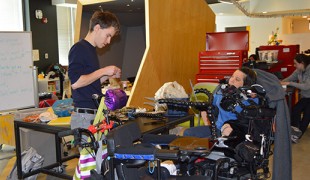- 4280
- 310
- 11
- 6
- 0
- Help Ukraine
About the solution
Pappardelle (username on the Instructables website) has a family member who suffers from Amyotrophic lateral sclerosis (ALS) as was exhibiting symptoms similar to tetraplegia (complete loss of muscular function, inability to sit upright and need for specialised hoisting). This meant that it was a challenge to transport the person between the two floor of their house.
The solutions available on the market where either too expensive or required major alterations to the property structure, making them impossible to implement. So Pappardelle decided to step in and build a hoist lift that would carry the relative up and down the stairs. The design was inspired by the charlifts of skiing resorts and cost around 450GBP
The equipment was made out of readily available materials and making use of common tools (hand saw, jig saw, hacksaw, drill, drill press, files, wood chisel, hammer, screw driver, level and measuring tape). The overall frame is made out of wood polls, attached to the floor and staircase, with two beams that span the entire length of the staircase and that form a track that allows for the up and down movement of the carriage.
The movement is guaranteed through the use of wheels and parts taken from skateboards. The individual puts on a sling and is hung on the system through a hook, being transported up or down the stairs.
Pappardelle says that “the ride is not quite smooth” as with a commercial solution “but this has been no problem with my relative” and has solved the issue for a fraction of the cost.
The design plan and comprehensive list of materials can be found at: https://www.instructables.com/Disabled-hoist-lift/
This solution shall not include mention to the use of drugs, chemicals or biologicals (including food); invasive devices; offensive, commercial or inherently dangerous content. This solution was not medically validated. Proceed with caution! If you have any doubts, please consult with a health professional.
DISCLAIMER: This story was written by someone who is not the author of the solution, therefore please be advised that, although it was written with the utmost respect for the innovation and the innovator, there can be some incorrect statements. If you find any errors please contact the patient Innovation team via info@patient-innovation.com
-
-
508
-
0
-
7329

Scooter for disabled people
MOVING IN A WHEELCHAIR: Moving using a wheelchair.
CAREGIVING
Amyotrophic Lateral Sclerosis
Assistive Daily Life Device (to help ADL)
Walking Aid (wheelchair/walker/crutches)
Gait abnormalities (e.g., walking difficulties, unsteady gait)
Muscle cramps or spasms
Difficulty coordinating movements
Stiffness or rigidity (difficulty moving)
Paralysis of the legs and lower body
Muscle weakness
Fatigue
Restoring mobility
Promoting self-management
Rehabilitating After Stroke
Managing Neurological Disorders
Promoting inclusivity and social integration
Preventing (Vaccination, Protection, Falls, Research/Mapping)
Caregiving Support
Neurology
Orthopedics
Rheumatology
United States
-
-
-
339
-
0
-
4891

Woman with disability invents assistive technology
CAREGIVING
Grip
Cerebral Palsy
Assistive Technology access
Assistive Daily Life Device (to help ADL)
Tremors
Muscle cramps or spasms
Difficulty coordinating movements
Stiffness or rigidity (difficulty moving)
Paralysis of the legs and lower body
Muscle weakness
Trouble with fine motor skills (e.g., writing, buttoning clothes)
Twitching or involuntary movements (myoclonus)
Restoring mobility
Promoting self-management
Managing Neurological Disorders
Promoting inclusivity and social integration
Caregiving Support
Medical Genetics
Neurology
Rheumatology
United States
-
-
-
338
-
0
-
4173

Collaborator Pierluigi Mantovani creates Evolution Devices - solutions that aim to transform Multiple Sclerosis Management
CAREGIVING
BODY BALANCE: Maintaining body balance
STANDING UP: Standing up from a seated position
WALKING: Walking
Multiple Sclerosis
Assistive Daily Life Device (to help ADL)
Walking Aid (wheelchair/walker/crutches)
App (Including when connected with wearable)
AI algorithm
Body-Worn solutions (Clothing, accessories, shoes, sensors...)
Restoring mobility
Regaining sensory function
Managing pain
Promoting self-management
Preserving Organ Function
Managing Neurological Disorders
Maintaining Balance and Mobility
To improve Treatment/Therapy
Preventing (Vaccination, Protection, Falls, Research/Mapping)
Raise awareness
Caregiving Support
General and Family Medicine
Internal Medicine
Medical Genetics
Neurology
Physical Medicine and Rehabilitation
United States
-
 en
en